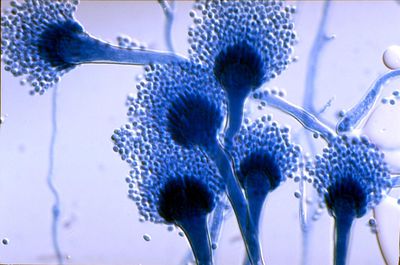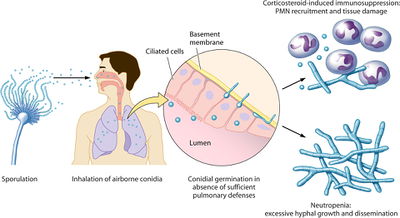Aspergillus fumigatus and Aspergillosis: Difference between revisions
| Line 69: | Line 69: | ||
===Innate Immune Response=== | ===Innate Immune Response=== | ||
<i>A. Fumigatus</i> begins its life cycle with asexual reproduction, producing airborne spores, called conidia [[#References|[2]]]. If these spores are inhaled by individual with a properly working immune system, the spores rarely make it all the way to the bronchioles and alveoli. The conidia first encounter the mucosa that lines the respiratory tract, where complement is activated. The overwhelming majority of the spores are removed via mucociliary clearance. those that survive make their way to the aveoli where they are phagocytized by aveolar macrophages | <i>A. Fumigatus</i> begins its life cycle with asexual reproduction, producing airborne spores, called conidia [[#References|[2]]]. If these spores are inhaled by individual with a properly working immune system, the spores rarely make it all the way to the bronchioles and alveoli. The conidia first encounter the mucosa that lines the respiratory tract, where complement is activated. The overwhelming majority of the spores are removed via mucociliary clearance. those that survive make their way to the aveoli where they are phagocytized by aveolar macrophages. Alveolar macrophages are the main phagocytic cells in the respiratory tract [[#References|[2]]]. When PRRs on the surface of the macrophages recognize pathogen-associated molecular patterns (PAMPs) on the surface of the conidia, an inflammatory response is triggered. One PRR, dectin-1, recognizes the fungal cell wall carbohydrate beta(1,3)-glucan. Dectin-1 cannot recognize resting conidia however, since beta(1,3)-glucan is hidden behind another layer of the cell wall until germination begins. | ||
After engulfing the pathogen, the alveolar macrophage uses reactive oxidant intermediates to kill the conidia (philippe, et al). | |||
Alveolar macrophages are the main phagocytic cells in the respiratory tract [[#References|[2]]]. When PRRs on the surface of the macrophages recognize pathogen-associated molecular patterns (PAMPs) on the surface of the conidia, an inflammatory response is triggered. One PRR, dectin-1, recognizes the fungal cell wall carbohydrate beta(1,3)-glucan. Dectin-1 cannot recognize resting conidia however, since beta(1,3)-glucan is hidden behind another layer of the cell wall until germination begins. | |||
==Treatment== | ==Treatment== | ||
Revision as of 16:04, 26 July 2015


Etiology/Bacteriology
Taxonomy
Superkingdom = Eukaryota
Kingdom = Fungi
Subkingdom = Dikarya
Phylum = Ascomycota
Subphylum = Pezizomycotina
Class = Eurotiomycetes
Subclass = Eurotiomycetidae
Order = Eurotiales
Family = Aspergillaceae
Genus = Aspergillus
Species = A. fumigatus
[1]
Description
Aspergillus fumigatus, a saprophytic fungus, can opportunistically cause a multitude of diseases in humans [2]. A. fumigatus, which primarily lives in soil and decaying vegetation, can be dispersed through the air as asexual spores, known as conidia. Because of this, humans usually get infected with the fungus by inhaling these conidia. In a given day someone inhales an average of 200 A. fumigatus spores [2]. In heathy individuals, the innate immune system kills all of the conidia that the body encounters; however, in immunocompromised individuals A. fumigatus infection is a serious concern.
Invasive aspergillosis (IA), which is primarily caused by A. fumigatus, is very severe and life-threatening infectious disease [3].
Pathogenesis
Life Cycle

Transmission
Aspergillus fumigatus is primarily transmitted through the inhalation of fungal spores, called conidia [2]. A. fumigatus conidia can be found ubiquitously in both indoor and outdoor environments, so people are continuously inhaling the fungi. The continued presence of A. fumigatus is usually not a problem; however, without proper respiratory tract immune defenses infection can occur.
Colonization
In order for Aspergillus fumigatus to colonize the respiratory tract, it must first evade the innate immune system, which is usually very effective at removing the pathogen in healthy individuals [2]. Gliotoxin, helvolic acid, and fumagillin are believed to help slow ciliary beat frequency, which likely interferes with mucociliary clearance. A. fumigatus conidia that survive mucociliary clearance bind to damaged respiratory epithelial cells and the basement membrane using sialic acid residues [4]. Sialic acid residues are likely required for parthenogenesis, since pathogenic species of aspergilli have more sialic acid residues. After binding to the epithelial cells, the conidia are engulfed into a phagosome where the conidia can begin to germinate [5]. A. fumigatus has also been shown to inhibit apoptosis in a variety of epithelial cells. Proteases secreted by A. fumigatus help it to colonize neighboring healthy lung tissue [2].
Macrophage Evasion
Virulence Factors
Clinical Features
Symptoms
Symptoms of invasive aspergillosis (IA) are wide ranging, but patients generally experience chest pain, cough, malaise, weight loss, dyspnea and fever (Latge, 1999) [6]. However, patients could experience any number of these symptoms. For example, individuals with AI who were previously treated with corticosteroids do not have elevated temperatures.
Morbidity and Mortality
Host Immune Response
Innate Immune Response
A. Fumigatus begins its life cycle with asexual reproduction, producing airborne spores, called conidia [2]. If these spores are inhaled by individual with a properly working immune system, the spores rarely make it all the way to the bronchioles and alveoli. The conidia first encounter the mucosa that lines the respiratory tract, where complement is activated. The overwhelming majority of the spores are removed via mucociliary clearance. those that survive make their way to the aveoli where they are phagocytized by aveolar macrophages. Alveolar macrophages are the main phagocytic cells in the respiratory tract [2]. When PRRs on the surface of the macrophages recognize pathogen-associated molecular patterns (PAMPs) on the surface of the conidia, an inflammatory response is triggered. One PRR, dectin-1, recognizes the fungal cell wall carbohydrate beta(1,3)-glucan. Dectin-1 cannot recognize resting conidia however, since beta(1,3)-glucan is hidden behind another layer of the cell wall until germination begins. After engulfing the pathogen, the alveolar macrophage uses reactive oxidant intermediates to kill the conidia (philippe, et al).
Treatment
References
1. UniProt. Taxonomy: Species Aspergillus fumigatus. Available at http://www.uniprot.org/taxonomy/746128.
2. Dagenais T. and Keller N. Pathogenesis of Aspergillus fumigatus in Invasive Aspergillosis. Clin Microbial Rev. doi: 10.1128/CMR.00055-08. http://cmr.asm.org/content/22/3/447.full.
3. Tekaia F. and Latge JP. Aspergillus fumigatus: saprophyte or pathogen?. Current Opinion in Microbiology. doi: 10.1016/j.mib.2005.06.017. http://www.sciencedirect.com/science/article/pii/S1369527405000925.
4. Washylnka J., Simmer M., and Moore, M. Differences in sialic acid density in pathogenic and non-pathogenic Aspergillus species. Microbiology. http://mic.sgmjournals.org/content/journal/micro/10.1099/00221287-147-4-869?crawler=true&mimetype=application/pdf.
5. Washylnka J., and Moore M. Aspergillus fumigatus conidia survive and germinate in acidic organelles of A549 epithelial cells. J. Cell Sci.. http://jcs.biologists.org/content/116/8/1579.long.
